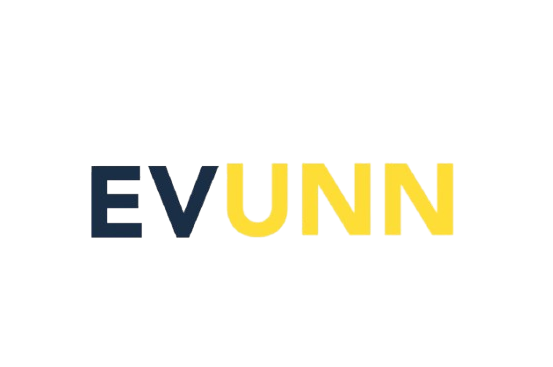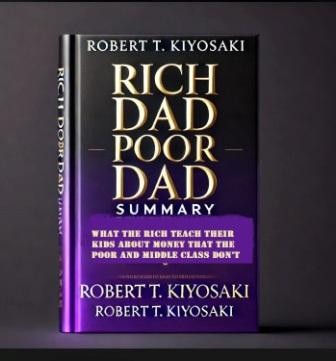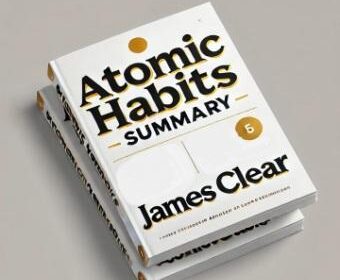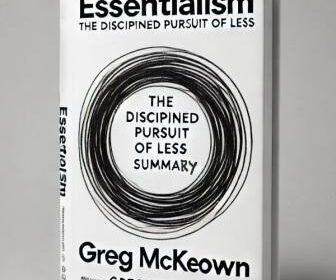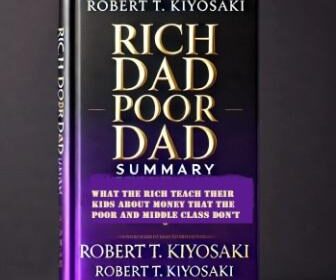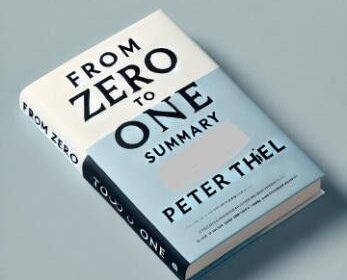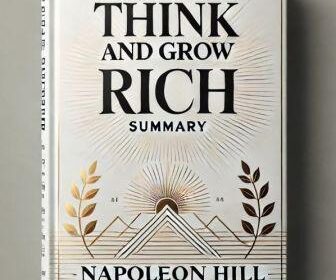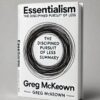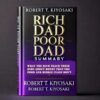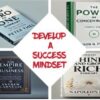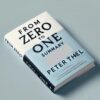RECOMMENDED BY
BUSINESS INSIDER
Business Insider, a leading business news publication, recognized Rich Dad Poor Dad as "one of the greatest personal finance books of all time." BUSINESS INSIDER
WILL SMITH
Will Smith, actor and producer Shared that he taught his son about financial independence by reading Rich Dad Poor Dad. WIKIPEDIA
"You’re only poor if you give up. The most important thing is that you did something. Most people only talk and dream of getting rich. You’ve done something." .
Robert Kiyosaki Tweet
Rich Dad Poor Dad Chapter Summaries
Imagine this: what if a few simple changes in how you think about money could completely transform your future?
That’s the promise of Rich Dad Poor Dad. This book is a wake-up call for anyone stuck in the paycheck-to-paycheck cycle or worried they’ll never get ahead financially.
But we know your time is precious, and diving into a full book can feel overwhelming. So, we created this summary—to give you the powerful lessons and insights in just a fraction of the time.
And trust us, once you see what’s inside, you’ll want the full book to dig even deeper.
Rich Dad Poor Dad
Read a Full Book in Minutes and grab the main ideas with Evunn book summaries
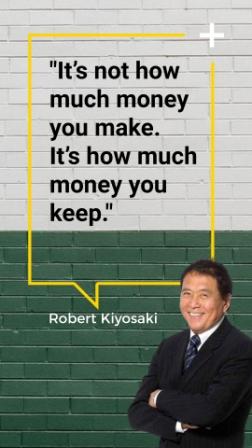
Introduction
What if everything you thought you knew about money was wrong?
Rich Dad Poor Dad by Robert Kiyosaki challenges everything society has taught us about wealth. It’s not a story about being born rich or lucky—it’s about learning the secrets of money that schools don’t teach.
Through the contrasting lessons of two father figures—his highly educated but financially struggling biological dad (Poor Dad) and his wealthy, street-smart mentor (Rich Dad)—Kiyosaki reveals the principles that can transform anyone’s financial future.
Is Rich Dad Poor Dad worth reading? I will say a big YES!
This book doesn’t just teach you how to make money—it reshapes how you think about money.
From the power of assets over liabilities to the importance of financial education, Kiyosaki provides actionable insights that anyone can use to escape the rat race and achieve financial freedom.
If you’re tired of living paycheck to paycheck or want to break free from the 9-to-5 grind, this is a must-read. Stay with me to uncover the key lessons from Rich Dad Poor Dad—lessons that could change your life forever.
If you don’t have this book yet, get it here on Amazon or listen to Rich Dad Poor Dad audiobook for free with Audible.
Click on the tabs below to read Rich Dad Poor Dad Summary by Chapters
Rich Dad Poor Dad review in one sentence:
This book teaches the importance of financial education, highlighting the difference between working for money and having money work for you by building assets and thinking like an investor.
Who Should Read Rich Dad Poor Dad?
- Aspiring Entrepreneurs: It provides a clear framework for thinking like a business owner and creating wealth.
- Employees Seeking Financial Independence: Learn how to move beyond the paycheck-to-paycheck mindset and build lasting financial security.
- Parents: Gain insights into teaching children about money, helping them develop financial literacy early.
- Anyone Struggling with Finances: Discover practical advice on breaking free from debt and poor spending habits.
Why Should you Read It?
Learn the Difference Between Assets and Liabilities: Most people confuse the two, and this book clears it up with relatable examples.
Develop a Growth Mindset: It challenges traditional beliefs about work, money, and education.
Practical Tips for Building Wealth: Offers actionable advice on investing, real estate, and creating passive income.
Inspiring Stories: The contrasting philosophies of the “rich dad” and “poor dad” make the lessons engaging and memorable.
Reading Rich Dad Poor Dad is an essential step for anyone looking to achieve financial freedom and live life on their terms.
Introduction: The Rich Don’t Work for Money
Robert shares his story of growing up with two father figures: his biological father (Poor Dad), who was highly educated but struggled financially, and his best friend’s father (Rich Dad), a self-made millionaire.
The central lesson:
Poor Dad believed in working hard for money, getting a stable job, and saving for retirement.
Rich Dad believed in making money work for you by investing in assets and building wealth.
Kiyosaki introduces the idea that financial education is critical and that schools fail to teach it.
Chapter 1: The Rich Don’t Work for Money
This chapter introduces a key concept: stop working solely for a paycheck.
Young Robert and his friend Mike worked for Rich Dad, who paid them a meager amount. They learned that chasing higher wages keeps people trapped in the “rat race.”
Rich Dad taught them to look for opportunities to make money outside traditional jobs, like spotting problems and creating solutions.
Example: Robert noticed unused comic books in Rich Dad’s store. He created a small library for kids, charging 10 cents for admission, and split profits with Mike.
Chapter 2: Why Teach Financial Literacy?
The big lesson here: It’s not about how much money you make but how much you keep.
Assets put money in your pocket, while liabilities take money out.
Many people think their house is an asset, but if it doesn’t generate income, it’s a liability.
Kiyosaki explains the importance of building assets like real estate, stocks, or businesses instead of focusing on acquiring liabilities (like luxury cars bought on credit).
Chapter 3: Mind Your Own Business
Lesson: Start building your asset column, even if you work a 9-to-5 job.
Rich Dad emphasized that working for others makes the employer richer, not you.
Kiyosaki advises readers to keep their day job but focus on building investments and side businesses on the side.
Example: Instead of buying luxuries upfront, invest in assets that generate income. Use that income to buy luxuries later.
Chapter 4: The History of Taxes and the Power of Corporations
Kiyosaki explains how the wealthy use corporations and tax laws to their advantage.
The poor and middle class earn money, pay taxes, and spend what’s left.
The rich earn money, spend on business expenses, and pay taxes on what’s left.
Key point: Learn how taxes work and use legal loopholes like creating a corporation to reduce your tax burden.
Chapter 5: The Rich Invent Money
This chapter focuses on creating opportunities rather than waiting for them.
Rich Dad taught Robert that courage, creativity, and financial knowledge help you spot investments others overlook.
Most people avoid risks, but the rich take calculated risks and learn from failures.
Example: Kiyosaki and his wife bought run-down properties, fixed them up, and rented them out for passive income.
Chapter 6: Work to Learn—Don’t Work for Money
Lesson: Focus on skills, not just paychecks.
Poor Dad encouraged Robert to specialize in one field, but Rich Dad advised him to learn multiple skills.
Working in different jobs teaches you sales, marketing, management, and leadership, which are crucial for entrepreneurship.
Kiyosaki himself worked as a salesman for Xerox to master sales skills before launching his own business.
Chapter 7: Overcoming Obstacles
The biggest barriers to wealth are fear, cynicism, laziness, bad habits, and arrogance.
Fear: Many people don’t invest because they’re afraid of losing money. Kiyosaki advises embracing failure as a learning opportunity.
Cynicism: Don’t let doubts or others’ opinions stop you from taking action.
Laziness: Avoid using “I’m too busy” as an excuse to neglect building wealth.
Example: Rich Dad taught Robert to face his fears of losing money by starting small, learning, and growing his investments over time.
Chapter 8: Getting Started
This chapter gives actionable advice:
- Set clear goals. Decide why you want to achieve financial freedom.
- Choose your friends carefully. Surround yourself with people who challenge and inspire you.
- Learn to manage risks. Study investing and take calculated risks.
- Take action. Don’t overanalyze; start small but start now.
Kiyosaki emphasizes the importance of continuous learning and suggests reading books, attending seminars, and finding mentors.
Chapter 9: Still Want More? Here Are Some To-Do’s
Kiyosaki ends the book with practical steps:
Start building your financial IQ by understanding accounting, investing, markets, and law.
Keep your expenses low and invest the difference in assets.
Pay yourself first: Save and invest before paying bills or buying luxuries.
Example: He suggests finding a real estate deal or starting a small business to practice applying what you’ve learned.
Final Thoughts
Rich Dad Poor Dad challenges conventional wisdom about money and teaches readers to rethink how they approach work, saving, and investing. The core takeaway is simple: focus on financial education, build assets, and let your money work for you.
Here are the things you need to start doing right now:
1. Track Your Financial Situation
Action: Write down all your income sources, expenses, assets, and liabilities.
How to Do It:
Use a spreadsheet or a budgeting app like Mint or YNAB.
Identify where your money is going and which items are liabilities (e.g., loans, car payments).
Highlight areas where you can cut unnecessary expenses.
2. Start Building an Emergency Fund
Action: Save at least 3–6 months’ worth of living expenses.
How to Do It:
Set up a separate savings account.
Automate a portion of your paycheck to go directly into savings.
Begin with small, consistent contributions.
3. Begin Building Your Asset Column
Action: Start investing in assets that generate passive income.
How to Do It:
Research low-cost index funds or REITs (Real Estate Investment Trusts).
Start small with platforms like Robinhood or Acorns if you’re a beginner.
Consider investing in real estate by exploring rental properties or crowdfunding platforms.
4. Pay Yourself First
Action: Set aside a portion of your income for investments and savings before paying bills or spending.
How to Do It:
Allocate at least 10% of your monthly income toward savings or investment accounts.
Treat this as a non-negotiable expense, just like rent or utilities.
5. Learn Financial Literacy
Action: Commit to learning the basics of money management and investing.
How to Do It:
Read books like The Intelligent Investor by Benjamin Graham or The Richest Man in Babylon.
Follow financial podcasts or YouTube channels for actionable advice.
Take online courses on budgeting, investing, or real estate.
6. Start a Side Hustle
Action: Explore ways to generate additional income outside your primary job.
How to Do It:
Identify your skills or hobbies that could be monetized (e.g., freelance writing, tutoring, or graphic design).
Use platforms like Fiverr, Upwork, or Etsy to market your services or products.
Dedicate a few hours weekly to building and growing this side business.
7. Practice Delayed Gratification
Action: Avoid impulsive purchases and focus on long-term financial goals.
How to Do It:
Before making a purchase, ask yourself if it’s a need or a want.
Set a “cool-off” period for big expenses to ensure they align with your goals.
Use the extra money saved to invest or pay down debt.
8. Network with Like-Minded People
Action: Surround yourself with people who understand and support your financial goals.
How to Do It:
Attend local or online meetups for entrepreneurs and investors.
Join communities like BiggerPockets (for real estate) or personal finance forums.
Seek out a mentor who can guide you in building wealth.
9. Set Specific Financial Goals
Action: Write down clear, measurable financial goals for the short and long term.
How to Do It:
Example: “Save $10,000 for investment within one year.”
Break your goal into smaller monthly targets.
Regularly review your progress and adjust your strategy as needed.
10. Start Taking Calculated Risks
Action: Step outside your comfort zone and explore new investment opportunities.
How to Do It:
Begin by investing small amounts in areas like stocks, ETFs, or cryptocurrency.
Research extensively and diversify your investments to minimize risk.
Accept that mistakes are part of the learning process and focus on long-term growth.
Final Note:
These steps don’t require perfection; they require commitment. Start small, be consistent, and learn as you go. Building wealth is a journey, and taking action now is the most critical step to financial freedom!
“The poor and the middle class work for money. The rich have money work for them.”
This emphasizes the importance of creating passive income streams rather than relying solely on a paycheck.
“It’s not how much money you make. It’s how much money you keep.”
Highlights the need for smart financial management and avoiding unnecessary expenses.
“The single most powerful asset we all have is our mind. If it is trained well, it can create enormous wealth.”
Encourages readers to invest in financial education and mindset development.
“Don’t let the fear of losing be greater than the excitement of winning.”
A reminder to take calculated risks and not let fear hold you back from opportunities.
“Winners are not afraid of losing. But losers are. Failure is part of the process of success.”
Encourages resilience and learning from failures instead of avoiding risks altogether.
“You’re only poor if you give up. The most important thing is that you did something. Most people only talk and dream of getting rich. You’ve done something.”
A motivational call to action for readers to start taking steps toward their financial goals.
“In the real world, the smartest people are people who make mistakes and learn. In school, the smartest people don’t make mistakes.”
Highlights the difference between traditional education and practical life lessons.
“The love of money is not the root of all evil. The lack of money is the root of all evil.”
Challenges a common misconception and reframes the conversation about wealth.
“Financial freedom is available to those who learn about it and work for it.”
A simple yet powerful reminder of the value of financial literacy and effort.
“The richest people in the world look for and build networks; everyone else looks for work.”
Stresses the importance of building relationships and leveraging networks for success.
“Money comes and goes, but if you have the education about how money works, you gain power over it and can begin building wealth.”
Highlights the importance of financial literacy over simply earning money.
“The rich focus on their asset columns while everyone else focuses on their income statements.”
Emphasizes building assets that generate income instead of relying only on a paycheck.
“The most life-destroying word of all is ‘tomorrow.'”
A call to action to start working on your financial goals today, not procrastinate.
“If you want to go somewhere, it is best to find someone who has already been there.”
Stresses the importance of learning from mentors and successful individuals.
“The only difference between a rich person and a poor person is how they use their time.”
A reminder to focus on productive activities that build wealth and value.
“The fear of being different prevents most people from seeking new ways to solve their problems.”
Encourages readers to think outside the box and challenge conventional norms.
“Find out where you are at, where you are going, and build a plan to get there.”
Advocates for setting clear financial goals and creating a roadmap to achieve them.
“People who avoid failure also avoid success.”
A reminder that failure is a stepping stone to growth and eventual achievement.
“In today’s fast-changing world, the people who are not taking risks are the risk takers.”
Encourages readers to embrace calculated risks to adapt and thrive in a dynamic economy.
“Sometimes you win, and sometimes you learn.”
A positive outlook on failure as an opportunity for growth and education.
“When you are young, work to learn, not to earn.”
Advises focusing on acquiring skills and experience rather than chasing immediate income.
“Great opportunities are not seen with your eyes. They are seen with your mind.”
Encourages creativity and a mindset that identifies potential where others see obstacles.
“A job is only a short-term solution to a long-term problem.”
Challenges the idea of job security as a sole path to financial success.
“The rich invent money.”
Highlights how wealthy individuals create opportunities and wealth through innovation.
“Emotions are what make us human. Make us real. The word ’emotion’ stands for ‘energy in motion.’ Be truthful about your emotions, and use your mind and emotions in your favour, not against yourself.”
Encourages emotional intelligence and self-awareness in financial decision-making.
Here are books similar to From Zero to One:
The Power of Concentration by Theron Q. Dumont
Think and Grow Rich by Napoleon Hill
The Empire of Business by Andrew Carnegie
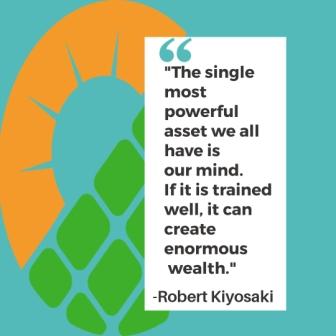
Rich Dad Poor Dad Summary PDF FREE Download
Get your own copy of the summary, read at your time. It’s FREE
Robert T. Kiyosaki is an entrepreneur, investor, motivational speaker, and financial educator best known for his Rich Dad series of books.
Born on April 8, 1947, in Hilo, Hawaii, Robert served in the U.S. Marine Corps before becoming a businessman.
His financial philosophy centres on teaching others how to achieve financial independence through investing, entrepreneurship, and financial literacy.
With over 20 years of experience teaching millions worldwide, Kiyosaki has become a trusted voice in personal finance.
Book Details
Title: Rich Dad Poor Dad: What the Rich Teach Their Kids About Money That the Poor and Middle Class Do Not!
Genre: Personal Finance, Business, Self-Help
Format: Paperback, eBook, Audiobook
Publication Date: First published in April 1997
Number of Pages: 336 (varies slightly by edition)
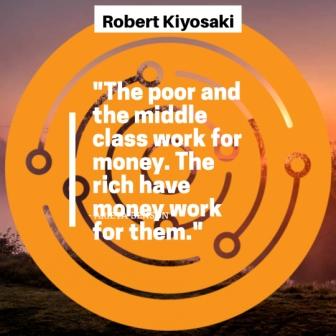
Test your Knowledge
Choose the correct answer from the options below

Time's up
Read the full book
You may also like
Small habits, big results—Atomic Habits by James Clear shows you how tiny changes can transform your life. Break…
Are you tired of feeling stretched too thin, juggling endless tasks but making little progress? This book teaches…
Learn powerful lessons on money, investing, and building wealth from the contrasting mindsets of two father figures. This…
Ready to uncover the secrets of building a business that truly stands out? Zero to One by Peter…
Ever wonder what separates successful people from the rest? Think and Grow Rich unlocks the timeless secrets of…
